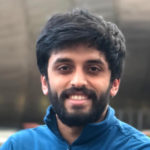joined the THREAD project in December 2020 (read his welcome message)
I am Indrajeet Patil from India. My enthusiasm towards the silhouette of tall superstructures in today’s rapid urbanization and the subtle art by which these “mighty giants” are designed to obey the laws of Strength, Stiffness, Stability and Synergy inspired me to pursue a Bachelor of Civil Engineering from SPPU (University of Pune), India. I further moved to the United Kingdom to pursue a Master of Science (M.Sc.) in Structural Engineering from the University of Glasgow, Scotland. An outstanding academic record coupled with a rich industrial practice as a consulting engineer are the fundamental roots of my engineering excellency.
Along with studying engineering structures, I further developed a multi-disciplinary approach into biomechanical, aerospace, and mechanical engineering. My master’s degree thesis comprised of developing a sophisticated numerical model and nonlinear simulation of adaptive bone remodelling process in proximal femur based on an open system thermodynamics approach (time-dependent density, local creation of mass etc.) with an interesting extension of the femur bone as a biomimetic inspiration in structural engineering. Several other sci-fi inspired research projects in my course, such as space elevator dynamics and mathematical modelling of tethered space systems although far away from reality, were an enjoyable way to learn highly complex theories in nonlinear dynamics and computational science. Structural forensics and fracture mechanics have also been a key part in my research and industrial practice.
My research interests in multibody dynamics, geometrically exact formulations, contact mechanics, large-deformation structures, vibration and crowd dynamics and multiscale modelling along with a passionate drive to obtain a doctorate inspired me to take part in the THREAD project. As a fellow ESR, understanding the nonlinear behaviour of highly flexible slender structures, their interactions, and mathematical constraints to provide groundbreaking advancements in the industry is a challenging opportunity for which I am fully equipped and confident to excel in. This project shall help me to develop a strong network of brilliant fellow scientists, collaborate with industrial partners, and explore new settings in the academia to break new grounds in research, and finally unlock several doors to a bright career in research.
Indrajeet Patil, December 2020

